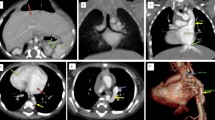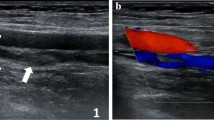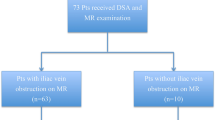Abstract
Background
Physiological flow direction of ascending lumbar vein (ALV) is not well recognized.
Methods
Two-dimensional time-of-flight magnetic resonance angiography (MRA) examinations of the lower extremities in 44 patients and venography (MRV) in 59 patients were retrospectively reviewed. χ2 analysis was used to compare the frequency of ALV detection between the MRA and MRV groups and between cases with filling defects above the ALV confluence and other cases in the MRV group.
Results
Frequency of ALV detection was significantly higher in the MRA group (60 of 88 veins, 68.2%) than in the MRV group (9 of 118 veins, 7.6%, P < 0.0001) and in cases with filling defects above the ALV confluence (8 of 23 veins, 34.8%; 6 were compression of the left common iliac vein by the right common iliac artery, 2 were thrombus of the proximal bilateral common iliac veins) than in other cases (1 of 95 veins, 1.1%) in the MRV group (P < 0.0001).
Conclusions
Without compression or occlusion above the ALV confluence, the general flow direction of the ALVs is not ascending but descending, suggesting that “descending lumbar veins” is a more physiologically precise name for these veins than ALVs.



Similar content being viewed by others
References
Umeoka S, Koyama T, Togashi K, et al. (2004) Vascular dilatation in the pelvis: identification with CT and MR imaging. Radiographics 24:193–208
Lawler LP, Corl FM, Fishman EK (2002) Multi-detector row and volume-rendered CT of the normal and accessory flow pathways of the thoracic systemic and pulmonary veins. Radiographics 22:S45–S60
Pagani JJ, Thomas JL, Bernardino ME (1982) Computed tomographic manifestations of abdominal and pelvic venous collaterals. Radiology 142:415–419
Sonin AH, Mazer MJ, Powers TA (1992) Obstruction of the inferior vena cava: a multiple-modality demonstration of causes, manifestations, and collateral pathways. Radiographics 12:309–322
Meaney JF (2003) Magnetic resonance angiography of the peripheral arteries: current status. Eur Radiol 13:836–852
Eiberg JP, Lundorf E, Thomsen C, et al. (2001) Peripheral vascular surgery and magnetic resonance arteriography—a review. Eur J Vasc Endovasc Surg 22:396–402
Snidow JJ, Harris VJ, Johnson MS, et al. (1996) Iliac artery evaluation with two-dimensional time-of-flight MR angiography: update. J Vasc Interv Radiol 7:213–220
Steffens JC, Link J, Schwarzenberg H, et al. (1999) Lower extremity occlusive disease: diagnostic imaging with a combination of cardiac-gated 2D phase-contrast and cardiac-gated 2D time-of-flight MRA. J Comput Assist Tomogr 23:7–12
Tatli S, Lipton MJ, Davison BD, et al. (2003) From the RSNA refresher courses: MR imaging of aortic and peripheral vascular disease. Radiographics 23:S59–S78
Anderson CM, Lee RE (1993) Time-of-flight techniques. Pulse sequences and clinical protocols. Magn Reson Imaging Clin N Am 1:217–227
Nesbit GM, DeMarco JK (1997) 2D time-of-flight MR angiography using concatenated saturation bands for determining direction of flow in the intracranial vessels. Neuroradiology 39:461–468
Lien HH, Kolbenstvedt A (1977) Phlebographic appearances of the left renal and left testicular veins. Acta Radiol Diagn (Stockh) 18:321–332
Kibbe MR, Ujiki M, Goodwin AL, et al. (2004) Iliac vein compression in an asymptomatic patient population. J Vasc Surg 39:937–943
Wolpert LM, Rahmani O, Stein B, et al. (2002) Magnetic resonance venography in the diagnosis and management of May–Turner syndrome. Vasc Endovascular Surg 36:51–57
Author information
Authors and Affiliations
Corresponding author
Rights and permissions
About this article
Cite this article
Morita, S., Kimura, T., Masukawa, A. et al. Flow direction of ascending lumbar veins on magnetic resonance angiography and venography: would “descending lumbar veins” be a more precise name physiologically?. Abdom Imaging 32, 749–753 (2007). https://doi.org/10.1007/s00261-006-9166-0
Published:
Issue Date:
DOI: https://doi.org/10.1007/s00261-006-9166-0




